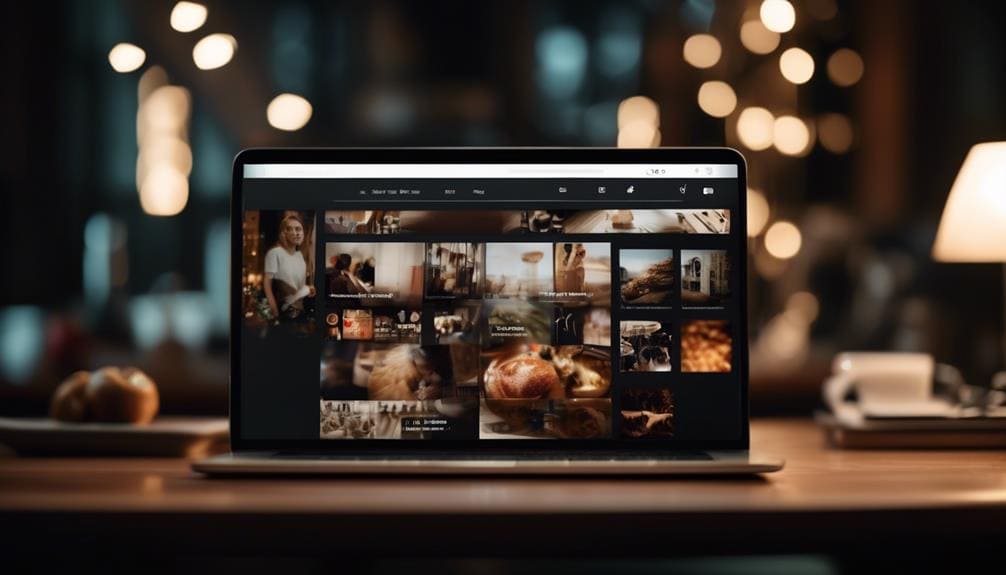Elevating Your Blog With SEO: Essential Techniques Every Blogger Should Know
When it comes to boosting your blog's visibility and attracting more readers, employing effective SEO tactics is akin to having a secret weapon in your arsenal. Imagine your blog not just existing but thriving in the vast digital landscape.
There are key techniques that can make this vision a reality, techniques that every serious blogger should be well-versed in. By incorporating these essential strategies, you can significantly enhance your blog's reach and impact.
Key Takeaways
- Conduct thorough keyword research to identify high-volume and niche-specific keywords for organic traffic growth.
- Optimize content for mobile-friendliness by focusing on responsive design, user experience, and mobile performance enhancements.
- Implement effective link building strategies such as outreach campaigns, guest blogging, social media sharing, and influencer collaborations to boost blog visibility and authority.
- Monitor and analyze user engagement metrics, track trends, and regularly update content to ensure blog success, relevance, and audience satisfaction.
Keyword Research

When conducting keyword research for your blog, begin by identifying high-volume keywords relevant to your niche to maximize organic traffic potential.
Conducting competitor analysis is crucial in understanding the keywords your competitors are targeting and the gaps you can fill.
Long tail keywords, though less competitive, can drive highly targeted traffic to your blog.
To excel in keyword research, use tools like SEMrush or Ahrefs to analyze your competitors' keyword strategy. Look for keywords with high search volume and low competition to increase your blog's visibility.
Incorporating long tail keywords that are specific to your niche can help you reach a more targeted audience and improve your blog's ranking on search engine results pages.
On-Page Optimization
To enhance your blog's search engine visibility and drive more organic traffic, implement effective on-page optimization strategies. On-page optimization involves optimizing various elements on your webpage to improve its search engine rankings. Two crucial aspects of on-page optimization are meta tags optimization and internal linking strategy.
Meta Tags Optimization:
Meta tags provide information about your webpage to search engines and users. By optimizing meta tags, you can improve your click-through rate and relevance in search results. Ensure your meta title, description, and keywords are relevant to your content and include target keywords.
Internal Linking Strategy:
Internal linking helps search engines understand the structure of your website and the relationship between different pages. Create a strategic internal linking strategy by linking relevant pages together using anchor text with relevant keywords. This not only improves user experience but also helps search engines navigate your site better.
| Meta Tags Optimization | Internal Linking Strategy |
|---|---|
| Optimize meta title, description, and keywords | Link relevant pages together |
| Include target keywords | Use anchor text with relevant keywords |
| Improve click-through rate | Enhance user experience and SEO |
Implementing these on-page optimization techniques will enhance your blog's SEO performance and drive more organic traffic.
Quality Content Creation

To boost your blog's SEO performance, you must master Keyword Optimization Strategies. By strategically incorporating relevant keywords into your content, you can enhance your blog's visibility and attract more organic traffic.
Additionally, Formatting for SEO is crucial in ensuring that your content is easily readable and optimized for search engine algorithms.
Keyword Optimization Strategies
How can you strategically incorporate keywords to enhance the quality of your blog content? When it comes to keyword optimization strategies, utilizing long-tail keywords and conducting competitor analysis are essential. Long-tail keywords, which are more specific and target niche audiences, can help improve your blog's visibility. Additionally, analyzing your competitors' keyword usage can provide insights into effective keyword strategies. Incorporating local SEO techniques tailored to your target audience can further enhance the relevance of your content. Balancing keyword density throughout your blog posts is crucial; it ensures that your content is optimized for search engines while maintaining readability. By implementing these keyword optimization techniques, you can elevate the quality of your blog content and attract more organic traffic.
| Keyword Optimization Strategies |
|---|
| Long-tail keywords |
| Competitor analysis |
| Local SEO |
Formatting for SEO
Enhancing your blog's SEO through strategic formatting can significantly elevate the overall quality and visibility of your content.
When it comes to formatting for SEO, two crucial elements to focus on are meta tags and structure. Meta tags provide search engines with information about your content, influencing how it's indexed and displayed in search results.
Structuring your content with a clear heading hierarchy and ensuring readability are essential for both users and search engines. Effective use of headings not only helps break down your content for readers but also provides search engines with a better understanding of your content's organization.
Image Optimization
To enhance your blog's SEO, understanding the importance of alt text and reducing image file sizes is crucial.
Optimizing alt text with relevant keywords can improve image search rankings, while reducing file sizes helps in boosting page loading speed, a key factor in SEO.
Alt Text Importance
Optimizing your blog images with descriptive alt text is essential for enhancing SEO performance and user experience simultaneously. Alt text provides visual accessibility for those who cannot view images and significantly impacts your site's SEO. When crafting alt text, follow best practices such as being descriptive, concise, and incorporating relevant keywords. By strategically optimizing your alt text, you can improve your blog's search engine rankings and attract more organic traffic. Enhancing the user experience through proper image descriptions not only benefits visually impaired users but also boosts overall engagement on your site. Remember, alt text serves a dual purpose: it improves SEO and ensures inclusivity for all users.
| Alt Text Importance | Benefits |
|---|---|
| Visual Accessibility | Ensures inclusivity |
| SEO Impact | Improves search rankings |
| Descriptive Alt Text | Enhances user experience |
| Relevant Keywords | Drives organic traffic |
| User Engagement | Boosts overall site interaction |
File Size Reduction
Crafting optimized alt text is pivotal in ensuring your blog's images aren't only visually accessible but also contribute to efficient file size reduction through strategic image optimization techniques. To enhance website speed and user experience, consider the following key strategies:
- Choose the Right File Format: Opt for modern formats like WebP to reduce file size without compromising quality.
- Utilize Compression Techniques: Employ tools like Gzip or Brotli to compress images for faster loading times.
- Resize Images Properly: Resize images to the exact dimensions required on your website to avoid unnecessary bulk.
- Implement Lazy Loading: Use lazy loading to defer offscreen images, prioritizing what's visible to the user for quicker initial loading.
Mobile-Friendly Design

Enhancing user experience through responsive web design is crucial for maximizing mobile traffic to your blog. With the increasing number of users accessing websites on mobile devices, having responsive layouts that adapt to various screen sizes is essential. A mobile-friendly design not only improves user experience but also positively impacts your blog's mobile performance, leading to higher engagement and potentially better rankings on search engines.
To ensure your blog is optimized for mobile, focus on creating a seamless experience across different devices. Utilize responsive design principles to make your content easily accessible and visually appealing on smartphones and tablets. Consider factors such as font size, button spacing, and image optimization to enhance usability on smaller screens. By prioritizing mobile-friendly design, you can cater to a broader audience and drive more traffic to your blog.
Incorporating mobile-friendly elements into your blog's design strategy is a forward-thinking approach that acknowledges the importance of mobile traffic in today's digital landscape. By prioritizing responsiveness and user experience, you can stay ahead of the curve and attract a larger audience to your blog.
Link Building Strategies
With a solid foundation in mobile-friendly design to drive traffic and enhance user experience, the next step is to establish effective link building strategies that can boost your blog's visibility and authority online. Link building is crucial for improving your blog's SEO and attracting more visitors.
Here are four innovative strategies to elevate your blog through strategic link building:
- Utilize Outreach Campaigns: Reach out to other bloggers and website owners in your niche to exchange backlinks and expand your network.
- Engage in Guest Blogging: Contribute high-quality content to reputable sites in your industry to gain backlinks and showcase your expertise.
- Leverage Social Media: Share your blog posts on various platforms to increase visibility and encourage others to link back to your content.
- Collaborate with Influencers: Partner with influencers in your field to create valuable content together and attract their audience to your blog.
User Experience Enhancement

Optimizing your blog's user experience is essential for engaging visitors and improving overall performance. When it comes to user experience enhancement, two critical aspects to focus on are navigation design and engagement tracking.
Key Elements for User Experience Enhancement:
| Navigation Design | Description | Benefits |
|---|---|---|
| Clear Menu Structure | Organize content logically for easy navigation. | Enhances user satisfaction. |
| Intuitive User Interface | Ensure buttons and links are easily clickable and lead to relevant pages. | Reduces bounce rates. |
| Mobile Responsiveness | Optimize for mobile devices to provide a seamless experience on all platforms. | Increases accessibility. |
Monitoring and Analytics
To elevate your blog's performance further, monitoring and analyzing key metrics is crucial for understanding user behavior and optimizing content strategies. By delving into monitoring and analytics, you can unlock valuable insights that drive your blog towards success. Here are four essential techniques to consider:
- Engagement Tracking: Keep a close eye on metrics like time spent on page, bounce rates, and social shares to gauge how well your content resonates with your audience.
- Conversion Analysis: Dive deep into conversion rates, click-through rates, and lead generation data to understand what prompts your readers to take action.
- Competitor Comparison: Analyze your competitors' strategies to identify gaps and opportunities for improvement in your own content marketing approach.
- Trend Identification: Stay ahead of the curve by monitoring trends in your niche, allowing you to create timely and relevant content that captivates your audience.
Frequently Asked Questions
How Can I Effectively Promote My Blog Using Social Media Platforms?
To effectively promote your blog on social media, collaborate with influencers for wider reach. Create viral content that resonates with your audience. Utilize these strategies to boost engagement and visibility across various platforms.
Are There Any Specific Strategies for Increasing Engagement on My Blog Posts?
To increase engagement on your blog posts, focus on blog design for easy navigation and visual appeal. Develop a content strategy that is informative, engaging, and tailored to your target audience's interests. These strategies can enhance reader interaction and retention.
What Are Some Common Mistakes Bloggers Make That Hinder Their SEO Efforts?
When bloggers neglect quality content and resort to keyword stuffing, their SEO efforts suffer. Avoiding these errors is crucial for boosting visibility and attracting a wider audience to your blog. Quality over quantity is key.
How Can I Optimize My Blog for Voice Search?
To optimize your blog for voice search, focus on user experience and follow voice search trends. Conduct keyword research to align your content with popular voice search queries. Enhance your blog's visibility by tailoring it to voice search optimization.
What Are Some Advanced SEO Techniques That I Can Implement to Further Improve My Blog's Search Rankings?
To boost your blog's search rankings, focus on advanced SEO techniques like link building for authority and content optimization for relevance. Enhance mobile responsiveness and user experience to captivate your audience and climb the rankings ladder.
Conclusion
In conclusion, by implementing key SEO techniques like keyword research, on-page optimization, and quality content creation, you can elevate your blog's visibility and reach a wider audience.
Remember to focus on user experience, mobile-friendly design, and link building strategies to further enhance your blog's performance.
By monitoring analytics and continuously refining your strategies, you can stay ahead of the competition and drive more organic traffic to your blog.
Keep optimizing and watch your blog soar to new heights in search engine rankings.








